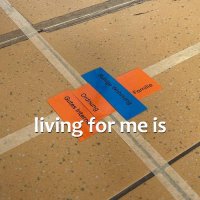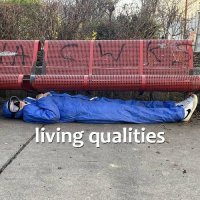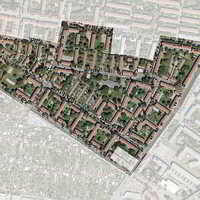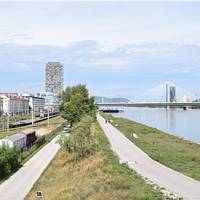Media Centre
Publication
The book on the project (pdf file opens in new window)
Design Studio - Material Collection
(pdf file opens in new window)
(pdf file opens in new window)
(pdf file opens in new window)
creativ workshop - Material Collection

Living for me is...
Description and tasks
PaneLS (english)
tafeln (deutsch)
(pdf files open in new window)

Living qualities
Description and tasks
(pdf file opens in new window)
VIDEOS
LIVING 2060
The LIVING 2060 project focused on promoting intercultural architectural dialog through design workshops and expert forums! It also aimed to convey the importance of architecture to children and young people so that they are equipped to be the critical citizens and decision-makers of tomorrow.
LIVING 2060 began in October 2019 and should be completed in September 2021. However, the coronavirus pandemic thwarted this plan and many things took a different turn.
This short film shows impressions from the unusual course of LIVING 2060.
Dr. Renate Hammer
Design Qualities for Sustainability
→With the resolution of the Green Deal in 2019, the European Union made a fundamental decision for the achievement of sustainability.
Explicitly areas such as renewable energies, biodiversity or circular economy are addressed. The goal is a climate-neutral economy within the Union by 2050. To succeed, the Green Deal includes a comprehensive investment plan. Furthermore, and fundamentally, the European Union is dependent on the support and a transformation of the economy to achieve its environmental goals, such as the Paris climate targets. The construction and real estate industry belong to those economic sectors with a particularly large environmental impact but also with a very effective lever to address the current environmental crises. The presentation will discuss the six environmental objectives of the EU-Taxonomy relevant for being qualified as a green economic activity in context with the design task: Climate Change Mitigation, Climate Change Adaptation, Water Resource Conservation, Circular Economy, Pollution Prevention, Biodiversity Protection and Restoration. These goals are presented away from partly detailed technical criteria, but as basic approaches to design. The aim is to introduce real professional requirements without demanding quantitative specifications at this point but basic design quality as crucial for achieving sustainability.
Dr. Cătălin Berescu
Happiness as Space
→Subjective well-being is a widely used sociological term that is central to quality of life surveys.
It usually deals with health, wealth, family and cultural activities, and tends to operate with spatial dimensions, otherwise seen as objective factors, as merely positive or negative perceptions of a certain user. This reflects a disciplinary divide, while architects are deeply engaged with their production as a form of art, sometimes fiercely subjective and highly personal, other disciplines treat it as a primarily functional, measurable product. We are going to address the issue of quality of housing through various lenses in order to understand the variety of visions and the difficulties of achieving a consensus over housing standards.
Wolfgang Fichna & Georg Vasold
A NEW NEIGHBOURHOOD - Vienna’s Postwar Rapid Building Program
→By the end of the 1940s a „Rapid Building Program“ initiated a new era of communal housing and urban development in Vienna.
With more than 1.700 accommodation units the Siemensstraße Housing Estate was the most prominent project of this program and attracted international attention. Architect Franz Schuster’s idea of a “New Neighbourhood” included playgrounds and pools for children as well as a home for the elderly and strip malls. Schuster also developed a so called Duplex-System which allowed to merge units in a straightforward manner further along the line. In this talk we will present Franz Schuster’s ideas and also cover the approaches of the first residents to the spatially restricted accommodation situation as well as their satisfaction with the architect’s implementation his concept.
Prof. Markus Tomaselli
HOUSING QUESTION : VIENNA´S ANSWER
→The lecture will provide a short history of urban development and (social) housing in Vienna,touching topics like urban renewal strategies, red vienna housing and settlers movements after the monarchy
and leading to the social housing superblocks from the sixties till the late 80ties. Finally the lecture will also show actual subsidized residential buildings and present the mayor topics in recent housing strategies and projects.
Sonja Gruber
Social Sustainability in Residential Housing in Vienna
→The talk will give a brief overview of the history of the fourth column of "social sustainability" in residential building in the city of Vienna, and the intersection between planning, building and social sustainability.
It will also give examples for the later moderation of community building processes when people move into residential building – the so-called "Besiedelungsbegleitung". Furthermore, the social impact of community gardening projects on residential areas will be investigated.
Markus Tomaselli
Social Housing in Vienna
Vera Marin
Ensemble – Housing of the Past getting better for the Future
→Collective housing ensembles built during the communist regime in Romania present some characteristics which embedded functionalist ideas about neighbourhood units, but also the public ownership of land and facilities built at the time.
Meanwhile, massive privatisation of the apartments (up to almost 100%) has changed their management procedures, but they could not change the physical environment as much as needed, especially during the economic transition period. Today, in the capital city of Bucharest, this housing stock is home for around 80% of the 2 million inhabitants (2011 census), and some of the buildings have been insulated, re-painted and repaired. But are they all viable options in the future for the many inhabitants who are also their co-owners? My interest for the collective housing ensembles started from the position of a young architect learning about urban regeneration in an integrated development master program which I graduated from at the turn of the century. Since then, it has been a journey in which I have combined the roles of both user and researcher in order to understand the respective situations in Romania and France (Copropriétés fragiles dans les grands ensembles) and to explore connections between public policies and urban design.
Dr. Maja Momi
Dwelling as a Fugitive Practice?
→For me, living is...the way we are and how we inhabit the planet, the city, a certain place; it's inseparable from other spheres of life, such as working, leisure, traveling, moving, etc.
It is something we often do not reflect on – we simply live, dwell, inhabit. As geographer and urban researcher Jürgen Hasse points out, as long as the day-to-day recurring matters of dwelling can be overcome, dwelling itself does not have to be of concern. In other words, extreme dwelling situations, marginal to the presumed centre/bourgeois normality, are most suitable for reflecting on – or rather dwelling upon – the notion of dwelling. In this lecture, I will share insights into my PhD project “Dwelling as a Fugitive Practice?”, in which I explore refugees’ dwelling practices in Hamburg through a mix of architectural and ethnographic methods. I argue that the diverse dwelling patterns and trajectories emerging through the practices of everyday life play a significant role in the processes of the production and negotiation of urban space.
Savinee Buranasilapin
Living as Project
→How do you live in an Asian megalopolis of 12 million inhabitants? Savinee will talk about living conditions in Bangkok, the city's function and dysfunction
as a dream or nightmare to live in, and how she designs her life and practice within that context. As a designer running a studio in Bangkok, she has taken on “living” as a life-long design project. She has found that an almost ideal urban life is possible not only despite Bangkok's failures, but because of them. Finding “livability” takes creativity.
Matthias Kaufmann
Holzmodulbau
Prof. Markus Tomaselli
VIENNA: URBAN TRANSFORMATIONS
Prasad Shetty
Small Forces
→Cities are composites of small forces – trips and kicks of its inhabitants, friendships and compassions.
This presentation will conceptualise the process of making a home in cities as an expression of small forces. This conceptualisation reworks the idea of “home” beyond the idea of “house”, and locates it in the desires and practices of people.
Cosmas D. Gozali
Shifting the Concept of Urban Living towards a New Paradigm
→The idea of “The Big City” still is very attractive for people from a wide range of economic and social backgrounds and leads many of them to move to large cities.
As a result, many large cities struggle to provide housing for their growing numbers of residents, which during the course of the 20th century has led to the problem of the co-existence of disparate classes of housing, ranging from luxury clusters to slum areas. However, there has been a shift – especially since the pandemic in 2020 – and a concurrent rapid development of technology that allows many people to work online, leading to fewer people needing to be physically present in large cities. These phenomena and work-from-home policies have encouraged many people to try to find a new definition of what is a comfortable place to live and work. A new paradigm has been established – the centre of economy does not necessarily have to be located in a large city but can, in principle, be anywhere in the world. Since the pandemic, many people have realised the importance of a connection with nature and green open spaces, and the idea of a new urban-living has emerged, one that is more sustainable, healthy and humane, using technologies that overcome the former problems of physical distance.
Dr. Arhya Nareswari
Kampung: an Indonesian Way of Life
Dr. Dyah Titisari Widyastuti
Yogyakarta: Culture of Living
Dr. Ikaputra
Yogyakarta's Historic City Layers
Dr. Cătălin Berescu
Rocket Science for the Poor
→Poverty is one of the areas that everybody knows about, that everybody has a theory about. It is one of the most banal subject matters, a trivial part of our common knowledge.
It is so much embedded in our personal experiences that we take for granted most of the reflections about it, most of the judgments about the poor and of the schemes that aim to solve it – as if they really did work. But then, why is there so much poverty out there, if apparently we already know what to do? This presentation will aim to showcase various ways of understanding poverty and how they are connected with design and planning, and will reflect on the special status of architects in an epistemic field dominated by other disciplines.
Dr. Zlata Vuksanovi-Macura
Legalising Inclusion
→Roma are Europe’s largest ethnic minority facing exclusion and discrimination, as well as unequal access to vital services.
In Serbia, there are about 600 informal settlements inhabited by Roma, who make up between 2-4% of the country’s total population. Illegal construction, inadequate access to drinking water and sanitation, poor quality of housing, overcrowding, and insecure tenure are some characteristics of these settlements. Key policy documents pledge to improve the Roma’s overall living conditions. But how can this be achieved? This presentation will outline some experiences from Serbia in legalising and upgrading Roma settlements, focusing on participatory and inclusive urban planning as one of the first steps towards improving Roma living conditions.
Dr. Ikaputra
Kampung´s House Renewal
→Kampung´s House Renewal is an effort to help families who cannot access housing of adequate quality within the Kampung neighbourhood.
A small amount of money made available by a company as a part of its social responsibility programme was used as seed funding to start to empower members of a family and their neighbours to help each other.
Dr. Jacopo Gresleri
Last, but not Least
→While the world is trying to find new ways of coexistence between the private and professional spheres (which have been so strongly conditioned by the Covid pandemic), there are large groups of people that are unable to meet their simplest housing needs, very often not even the most basic need of any kind of shelter.
The issue of the home for the "last" cannot be considered "the least" – a general commitment aimed at providing adequate answers for all can no longer be postponed. The area where some of us operate (the economically well-off western sphere) has at its disposal all the technical and regulatory tools that are necessary to remedy this situation of a deficit of rights. However, it is necessary to clarify the concept of current affordable housing, updating its identification through characteristics that take account of both architectural and political commitments.
Prof. Rupali Gupte
Housing in Mumbai: Policies, Programmes and Lived Realities
→Over the past 70 years since India’s independence, Mumbai has seen a slew of policies and programmes to address the issue of housing for the poor.
However, there still remains a glaring gap between demand and supply. This presentation lays out the range of housing delivery mechanisms that were initiated in Mumbai, and their subsequent takeover by market-driven, incentive-based initiatives in the 1990s, which have benefited developers. To bridge this gap, in recent times the city has been organising itself to provide a wide range of of unusual arrangements that are not dependent on the state and its incentives. This presentation makes a case for rethinking housing delivery and the definitions of home on the basis of these lived realities and collaborations on the ground.
Dr. Cătălin Berescu
Too big, too small, too ugly: minimal housing standards and the problem of poverty
→How small is too small when we think about a house for a family with little to no economic means? It looks that Austria has a great answer to this question, you just need 30 m².
That would be illegal in Romania, where you need at least 37, but then again, there is almost no social housing in Romania. Are the 11m² apartments in the center of Paris legal? They probably are, but are they moral? We will try to navigate through some examples and case studies from various parts of the world in order to take a look at how housing provisions and technical norms give an answer to the question of minimal needs, to the imperative of basic shelter rights and, last but no least, to the aesthetic imposition of architecture on a social issue.
Dr. Dyah Titisari Widyastuti
The Urban Housing and Transit Oriented Development
Dr. Ardhya Nareswari
Kampung: Indonesian urban settlements - the case of Yogyakarta
→Indonesia is an archipelago with a wide range of population densities on its various islands. Its most populous island is Java, which is home to over 55% of Indonesia's total population.
Yogyakarta is one of the cities in Indonesia that continues to grow, developing due to its role as a student city and major tourism and historical centre. The function of the settlement is thus influenced by the development of education and tourism. These activities have been supported by the existence of a kampung, an urban settlement with distinctive physical and social characteristics, which has developed with its particular set of problems and challenges.
Friedrich Hauer & Andre Krammer
"Wild" Vienna-looking back at a century of informal city development
→The development of Vienna in the 20th century was strongly influenced by informal settlements. On a structural level the traces of these formerly "wild" colonies or "Bretteldörfer" are still widely present in today’s city fabric.
1918, after the end of WWI, a large part of Vienna’s 2 million inhabitants was struck by severe famine, cold, disease and desperate housing conditions. In this precarious situation, several thousands - some sources speak of more than 100 thousand urbanites - were forced to self-empowerment. Illegal forest clearings, vegetable gardens and squats with primitive houses and sheds were expanding in the Danube floodplain and the alpine foothills, in the fields and wastelands on the fringes of the city. Albeit reduced in scale, this form of informal colonization reoccurred during the world economic crisis of the Thirties and in the instable, precarious years after WWII (Hauer & Krammer 2018; 2019). While some minor areas were cleared by the authorities, from the 1950s to the 1990s most former illegal settlements were upgraded, connected to public water-, power- and traffic infrastructure and legalized. As a consequence, former “slums” began to transform into high-value residential areas, dominated by posh single-family-houses in recent years – contributing to the current overheating of the city’s real estate market. The presentation will elaborate on this largely unknown history of Vienna, which is today one of the world’s seemingly most formalized urban environments.
Dr. Ikaputra
Affordable Living in Java-Indonesia
→"Affordable housing" is not just a matter of providing house that can be owned, bought, rented by people with limited or low income, but also how people can live in them.
Providing affordable housing must consider various aspects such as population growth, land, environmental capacity, community income, ownership systems, and how “designs” are generated from community-base ideas, architects, or from cultural systems embedded in the provision of affordable housing. Through history, Java—the most populous island in Indonesia—has taught lessons in providing "affordable housing" since the era of the aristocracy, the Dutch colonialism, the post-colonialism (after independence), and now.
Dr. Nguyen Quang
Viet Nam’s Case Study on Housing Development
→Dr. Nguyen Quang argues that current housing policies in Vietnam are not entirely suitable for the present situation and only provide a temporary solution to meet urgent housing needs.
Further reforms promoting a broader enabling housing policy are necessary to bring the efficiency and competitiveness for the official housing market. The private corporate sector and community housing development should be encouraged in the supply of diversified types of social and commercial housing to meet a wide range of demand from different income groups.
B. Povatong, P. Chayanun and S. Srisopon
Informal Living and Affordable Housing in Thailand
→This presentation provides an understanding for the housing problem in Thailand since 1940: from the government’s delayed response by setting up the National Housing Authority (NHA) in 1972 to the launch of the first 20-years housing plan in 2017.
It focuses on the characteristics of informal housing and its alternatives and explores the question of the future of affordable housing in urban Areas.
Dr. Cătălin Berescu
Informal Housing between Freedom and Anxiety
→Cătălin Berescu introduces his research about informal housing.
Using examples from his field work, he will elaborate on neighbourhoods of extreme poverty and the vast realm of emerging middle-class constructions in Romania, the Tiny House movement in the US and the cohousing communities from Berlin.
Prof. Rupali Gupte
Making Home: A Case of Mumbai
→Rupali Gupte demonstrates in her presentation how the Maharashtra government’s response to current housing requirements in Mumbai does not meet the demands for affordable housing
and ignores all forms of cultural specificity and people’s agencies of making homes. She argues that the concepts of ‘transactional capacity’ and ‘settling’ can be used to better understand the city’s rich housing landscape.



